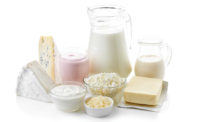In keeping with our musical theme this month, let’s start with a sound check. “Testing, testing. May I have a power chord, please?”
The dairy industry sounds good, from the mosh pit all the way to the cheap seats. In compiling our annual state of the dairy industry report (beginning on page 30), Associate Editor Sarah Kennedy, Ingredients Editor Kim Decker, myself and other contributors interviewed dairy processors and ingredient suppliers about trends in dairy foods and beverages. We analyzed sales data from IRI and production data from the National Agricultural Statistics Service.
Allow me to boil down (ultra-filter, if you will) our findings intro strengths, weaknesses, opportunities and threats.
It is hard to overstate the benefits of dairy foods and beverages. A cup of fluid milk efficiently delivers protein, calcium, vitamins and minerals cost-effectively. Besides being nutrient-dense, milk is versatile. It tastes good. People know what milk is and how to consume it.
Raw milk – the raw material for what you manufacture – is made in the USA and readily available. You can curdle it, churn it, freeze it and dry it into a trainload of products.
Milk takes flavor well. Beyond chocolate, vanilla and strawberry, fluid milk processors are adding nontraditional flavors, like pumpkin and peanut butter. Cheesemakers are on board, too. Consumers like cheeses spiced with hot peppers. Yogurt makers are expanding beyond the three berries, incorporating exotic fruits like mango and pomegranate into the white mass.
Yet with so many varied forms of dairy products available, the dairy industry has its weaknesses. Price is one. The average price of a gallon of milk reached a five-year high this spring ($3.68). A pound of American processed cheese is up to $4.50. That’s not going to change. World demand for milk is expected to keep prices up. Retailers can’t raise prices too much. To keep foods affordable, dairy processors are going to have to become more efficient manufacturers.
Let’s Go
Another weakness is that dairy foods are not portable. A sit-down meal has been replaced by a grab-and-go snack. Americans eat in their cars and at their desks. (Or they skip meals, like breakfast.) Dairy processors need to package their products in single-serve bottles and snack-size containers. Don’t let refrigeration hold you back. Use processing and packaging technologies to make shelf-stable dairy foods.
Because there are no national brands of milk and ice cream, no one has the resources to mount a national advertising campaign to tout the merits of these foods. Yogurt, on the other hand, is a category with many national brands and the budget. Ads for yogurt connote fun, family, nutrition and health.
These weaknesses present opportunities for creating line extensions and for pursuing new channels. As noted, fluid milk processors are adding seasonal milk products to complement their commodity white milk business. Ice cream makers have turned to gelato, a trendy food that they can package in pints and as stick novelties.
Explore opportunities in the value-added sector and extend your line with organic or natural dairy brands. Boost the protein content, add omega-3s or remove lactose. Leverage your brand name with your retail connections to get shelf space in other departments. Put your brand on products that you don’t currently make (find a co-manufacturer, if you have to).
Shopping habits have changed along with consumption habits. Besides the traditional grocery store, club stores, dollar stores, drug stores and convenience stores all carry dairy products. So do foodservice outlets like restaurants, schools, nursing homes and prisons. Home delivery services in urban areas also are potential customers for your products.
Dairy processors have an opportunity to educate a younger generation who love food but never learned how to cook from scratch. They are interested in locally sourced and better-quality ingredients, so develop recipes calling for milk, cream, butter, cheese, cottage cheese and yogurt.
If you can’t find customers in the United States, look abroad. Mexico, China and Latin America represent eager buyers for U.S. dairy ingredients, cheese and UHT milk.
Under Pressure
The threats to the dairy industry are many and very real. First, your fellow processors are a competitive threat. Second, animal-welfare activists will pressure you not to buy from dairy producers if they detect even a whiff of harm to cows.
The misinformation about milk circulating on the Internet and in social media harms your livelihood. So does the anti-science worldview that chooses not to acknowledge facts. Government regulations threaten innovation and sales. Overseas demand for U.S. dairy can limit supply at home and drive up prices. In case you forgot, soy and tree nuts have protein, too.
Celebrate Good Times
If you are totally discombobulated by now, re-read the beginning of this essay: “It is hard to overstate the benefits of dairy foods and beverages.”
The world changes. We change. How, when and where we eat is different than it was 20 years ago. But we still eat. The challenge is to develop products that fit the needs of your customers.




